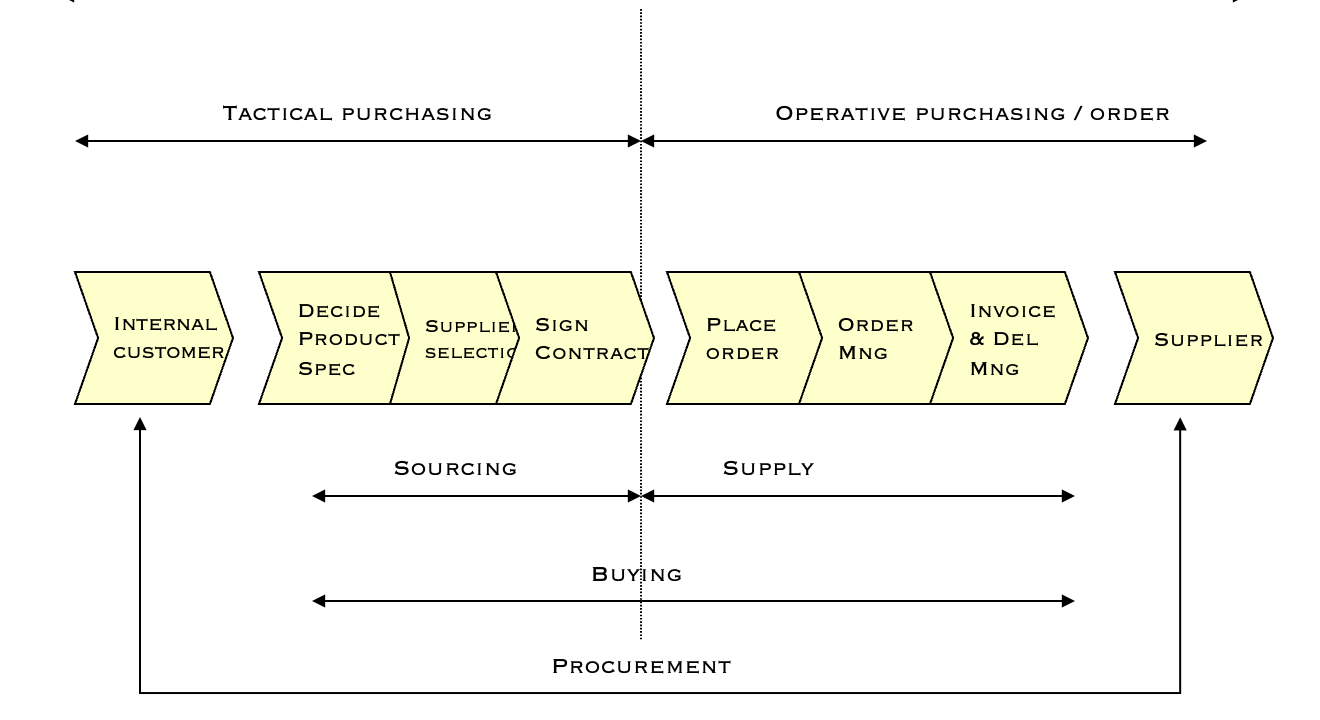Many times you see the description Strategic buyer where the tasks consist of sourcing and supplier management, activities Learn How to Source allocated to Tactical procurement role.
Content
Due to the sprawling descriptions of Strategic buyer, that role has been avoided. Strategic buyer, in job advertisements, is more an indication that the individual in question is experienced than a description of a role. Learn How to Source chooses to divide strategic buyer role into the roles Procurement Management and Tactical procurement.
Almost all organizations have a goal with their activities and a plan (strategy) to achieve the goals. A procurement function (and its suppliers) also contributes to the strategy by having the most suitable suppliers contracted (with the right kind of contract). The Procurement Manager (see course Procurement Management) controls and distributes the work within the procurement function with the help of three workflows:
- Category management.
- Processes and tools.
- Organization and resources.
The role of Tactical buyer and connection with operational procurement is described by Professor Arjan van Weele in the book Procurement and Supply Chain Management (new edition in spring 2022 (YouTube)).
Examples of tasks that are part of the Tactical Purchaser role are market analysis, RFQs, handling of supplier quotations, negotiation and contracting of the deliveries/services that the organization needs. This is done by participating in cross-functional category / procurement teams and execution of improvement initiatives. Supplier Management supports a differentiated commitment with suppliers and defines the most appropriate relationship. By optimizing supplier management, suppliers’ contributions are also optimized.
The role also includes coordination of product phasing in/out, project management in supplier development projects, the process Know your supplier (collection of information about suppliers and thereby reducing the risks that naturally arise in the supply chain), Supplier Audit (when and why it is appropriate to implement a Supplier Audit) and possibly a product qualification process.
The course Introduction to Tactical Procurement
In the course “Introduction to Tactical Procurement” the role is generally described. basic course on Tactical Procurement, designed to equip you with a general understanding of the tactical role within a procurement department. This course is tailored for professionals who are new to procurement or those looking to widen their knowledge in this critical business function.
Course Objectives:
By the end of this course, participants will be able to:
- Understand the role and importance of tactical procurement in an organization.
- Know the key processes for the tactical buyer role.
Course Outline:
Introduction to Tactical Procurement present the role and responsibilities of a tactical procurement professional including introduction of following key tactical processes:
- Market analyses.
- Spend analyses.
- Sourcing process.
- Contract Management.
- Supplier Development.
- Know your supplier.
- Supplier Audit.
- Product qualification.
Who Should Enroll:
- Procurement and supply chain professionals aiming to refine their tactical procurement abilities and establish a solid groundwork befor delving into the details of the tactical buyer role.
- Individuals interested in a career in procurement and want to build a general understanding of the tactical buyer role.
This course is designed to be interactive and practical, ensuring that participants not only gain theoretical knowledge but also develop the skills necessary to apply these concepts in their professional roles.
Sourcing Basics – get started as Tactical buyer
And if you want to get all the basics about the role the bundle “Sourcing basics – get started as Tactical buyer” will do the trick. A bundle of courses to understand; the 8 steps in a modern sourcing process, how to keep track of your supplier market, your suppliers risk and product qualification. All the basic processes in a tactical buyer’s everyday life.
- What is a market analysis? Why, how and when is a market analysis done? These are questions that are answered. EFFSO provide the basics around RFI, RFP and RFQ.
- A standardized procurement process consists of steps 1-4, process steps before sending a quote request to the market and steps 5-8, the process steps that prepare a quote request, contract a supplier and implement a new supply chain.
- Know your supplier involves collecting information about your suppliers and thereby reducing the risks that naturally arise in the supply chain.
- What is a Supplier Audit, when and why is it appropriate to conduct a Supplier Audit? After the course, you know.
- What a product qualification process when and if a tactical buyer should apply this process. The answers come in the course and in addition a general introduction to some standard qualification processes.
- Supplier development and how to build a supplier development program. EFFSO has the answer.
- Supplier Management supports a differentiated commitment with suppliers and defines the most appropriate relationship. By optimizing supplier management, suppliers’ contributions are also optimized.
- The last course is a 1 on 1 e-meeting (60 minutes) with a course instructor converting online lectures to real-life practice.
About Learn How to Source
Learn How to Source (LHTS) is an online platform based in Sweden, offering a range of procurement courses accessible globally. It serves as a community where procurement experts share their knowledge through online courses, designed for various experience levels from introductory to expert. Courses are concise, about 30 minutes each, and cover different aspects of procurement, tailored for different buyer roles. The courses focus on practical knowledge, presented by seasoned professionals, and include quizzes and certificates. They can be accessed from any device, emphasizing microlearning for flexibility and efficiency.
